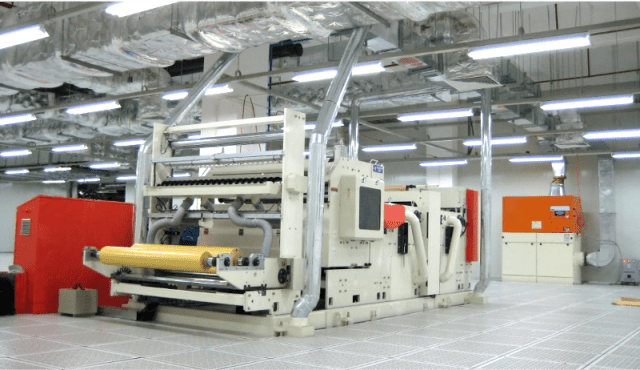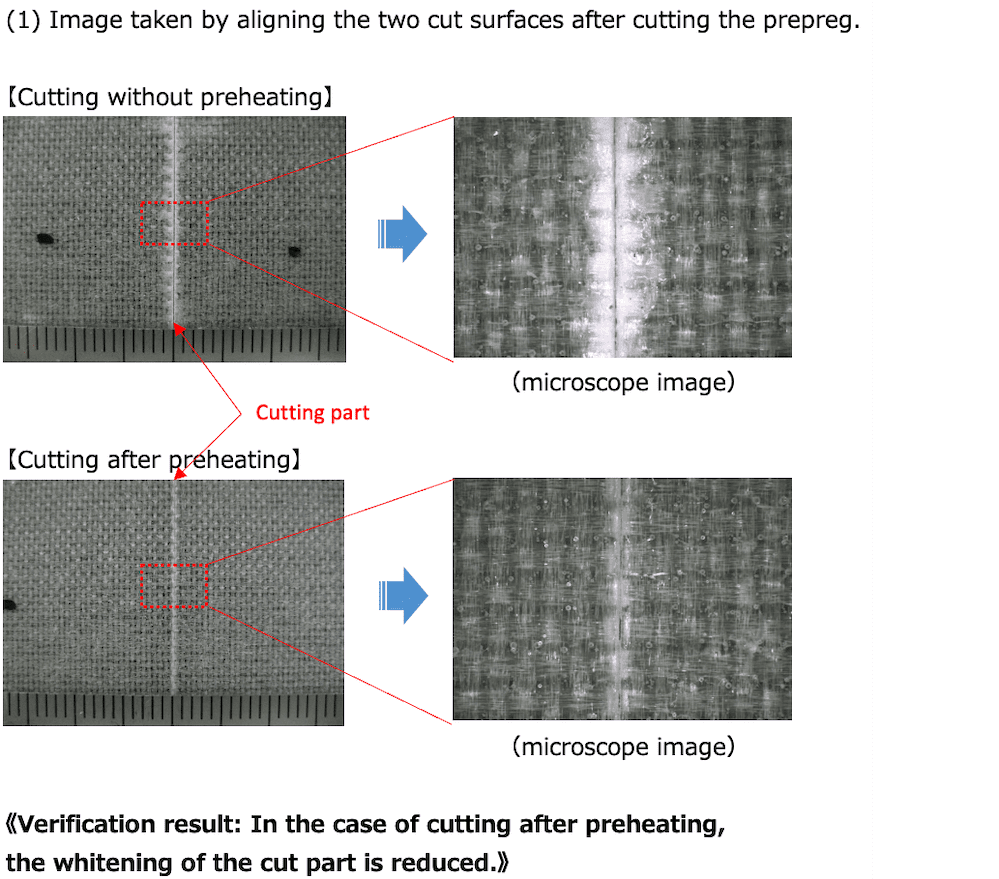【Prepreg Cutting Machine】Reducing defects for printed circuit board lamination!
2022-11-10
【Prepreg Cutting Machine】leads to solve the printed circuit board defects.
In the printed circuit board industry, these account for the majority of defects atlamination press process which are Glass powder and Resin powder generated at cutting process of materials (prepreg).
Especially in recent years, with the increasing number of layers and densities of circuit patterns and the miniaturization of hole drilling, there is a strong need to prevent the scattering and chipping of cutting dust, which causes contamination by foreign matter.
Therefore, Kitagawa Seiki has developed a 【Pre-preg cutting machine】 equipped with a new cutting function that greatly reduces the dust generation at cutting process by heating only the cutting part in advance using the heating technology that Kitagawa Seiki expertises.
Especially in recent years, with the increasing number of layers and densities of circuit patterns and the miniaturization of hole drilling, there is a strong need to prevent the scattering and chipping of cutting dust, which causes contamination by foreign matter.
Therefore, Kitagawa Seiki has developed a 【Pre-preg cutting machine】 equipped with a new cutting function that greatly reduces the dust generation at cutting process by heating only the cutting part in advance using the heating technology that Kitagawa Seiki expertises.
"Prepreg" used as an insulating material in Copper-clad laminate.
"Prepreg" is a sheet made by impregnating resin into glass cloth woven with highly insulating glass fiber.
It is used as an insulating material for "Copper Clad Laminate", which is the base material for all electronic circuits and printed circuit boards.
This copper clad laminate (CCL) will eventually form an electronic circuit on its surface and is used not only as a general electronic circuit board but also as a printed circuit board for industries such as communications, automobiles, aircraft, and space.
Copper clad laminates (CCL) are made by layering prepreg and copper foil (thickness 18 to 35 μm) on the top and bottom of the prepreg, then Kitagawa Seiki's main product laminating press "Multi-opening vacuum press" creates a single laminated product by controling vacuum, heat, and pressure.
It is used as an insulating material for "Copper Clad Laminate", which is the base material for all electronic circuits and printed circuit boards.
This copper clad laminate (CCL) will eventually form an electronic circuit on its surface and is used not only as a general electronic circuit board but also as a printed circuit board for industries such as communications, automobiles, aircraft, and space.
Copper clad laminates (CCL) are made by layering prepreg and copper foil (thickness 18 to 35 μm) on the top and bottom of the prepreg, then Kitagawa Seiki's main product laminating press "Multi-opening vacuum press" creates a single laminated product by controling vacuum, heat, and pressure.
Prepreg made of Glass and Resin.
Prepregs are typically manufactured in impregnation facilities.
A roll of glass cloth is unwound from the unwinding device, and is coated and impregnated with resin (mainly epoxy resin) in the pre-impregnation and impregnation devices.
After drying, hardening, and cooling processes, the semi-hardened prepreg is cut into rolls or plates (sheets) by a take-up device for commercialization.
This roll-shaped prepreg is called "prepreg original fabric".
In other words, this prepreg is a resin sheet that has been hardened to a semi-hardened state.
When this is heated and pressed by our laminating press equipment, the resin melts again and adheres to the copper foil.
A roll of glass cloth is unwound from the unwinding device, and is coated and impregnated with resin (mainly epoxy resin) in the pre-impregnation and impregnation devices.
After drying, hardening, and cooling processes, the semi-hardened prepreg is cut into rolls or plates (sheets) by a take-up device for commercialization.
This roll-shaped prepreg is called "prepreg original fabric".
In other words, this prepreg is a resin sheet that has been hardened to a semi-hardened state.
When this is heated and pressed by our laminating press equipment, the resin melts again and adheres to the copper foil.
Glass and Resin powder at prepreg cutting phase cause damage on copper foil.
Scratches and dents on the copper foil are cited as causes of defects in printed circuit boards. These scratches and dents are the cause of electrical conduction abnormalities.
Before the process of adhesing prepreg and copper foil with a laminating press, there is a process of laminating the material sheets that makes up the board.
This lamination process is generally performed in a clean room. This is to prevent contamination and dust from entering between the laminated materials.
However, even if the lamination process is performed in a highly clean room, scratches and dents may occur on the copper foil.
The causes are cutting powder adhering to the prepreg, glass powder and semi-hardened resin powder falling off the cut surface of the prepreg.
If cutting powder or fallen off dust get in between the copper foil and the prepreg during lamination, the thin copper foil will be scratched or dented in the press process of the laminating press in the next process.
Before the process of adhesing prepreg and copper foil with a laminating press, there is a process of laminating the material sheets that makes up the board.
This lamination process is generally performed in a clean room. This is to prevent contamination and dust from entering between the laminated materials.
However, even if the lamination process is performed in a highly clean room, scratches and dents may occur on the copper foil.
The causes are cutting powder adhering to the prepreg, glass powder and semi-hardened resin powder falling off the cut surface of the prepreg.
If cutting powder or fallen off dust get in between the copper foil and the prepreg during lamination, the thin copper foil will be scratched or dented in the press process of the laminating press in the next process.
Developing new prepreg cutting method with our specialty of heating technology.
As a solution to this problem, we have develpoed a cutting method by taking our specialty of heating technology that makes it possible to "reduce the scattering of
resin powder" during cutting and "suppress the fallen off of resin powder and glass powder" from the cut surface.
It is a method that pre-heats only the cut part (about 5 mm width) just before cutting. It is heated at 80 to 90°C, which is lower than the hardening temperature of
the impregnated resin.
By heating and softening the resin, it reduces resin powder scattering at cutting process.
Furthermore, by covering the cut surface with softened resin, we aimed to suppress the resin powder and glass powder fallen off from the cut surface.
resin powder" during cutting and "suppress the fallen off of resin powder and glass powder" from the cut surface.
It is a method that pre-heats only the cut part (about 5 mm width) just before cutting. It is heated at 80 to 90°C, which is lower than the hardening temperature of
the impregnated resin.
By heating and softening the resin, it reduces resin powder scattering at cutting process.
Furthermore, by covering the cut surface with softened resin, we aimed to suppress the resin powder and glass powder fallen off from the cut surface.
Kitagawa's prepreg cutting method greatly suppresses cutting powder generation.
As a result of developing and verifying the new prepreg cutting method mentioned as above, we were able to significantly reduce the generation of cutting powder
(see photo below).
However, it is difficult to reduce the cutting powder to zero. For this reason, the【Prepreg cutting machine】using the same method is equipped with a dust collection system that removes the generated cutting powder.
(see photo below).
However, it is difficult to reduce the cutting powder to zero. For this reason, the【Prepreg cutting machine】using the same method is equipped with a dust collection system that removes the generated cutting powder.
【Prepreg cutting machine】can be customized according to the application.
The 【Prepreg Cutting Machine】 developed by Kitagawa Seiki has a configuration in which the sheet-like prepreg unwound from the prepreg roll set on the unreel is vertically cut → temporarily stored → cross-cut process, and cut into small pieces.
Vertical cutting (cutting in the conveying direction) is combined with a heating ring and slitter (shear-cut method using upper and lower round blades), and horizontal cutting is combined with a heating bar and shearing (shear-cut method using upper and lower straight blades).
We can also configure and combine according to the customer's application, such as "only cross-cutting is required" or "we want options such as production control functions and inspection equipment installed" etc.
In addition, we have installed a demonstration machine of 【Prepreg cutting machine】 in our factory, so evaluation tests are also possible.
Please feel free to contact us as we will consider cutting machine that meets your requirements as much as possible.





